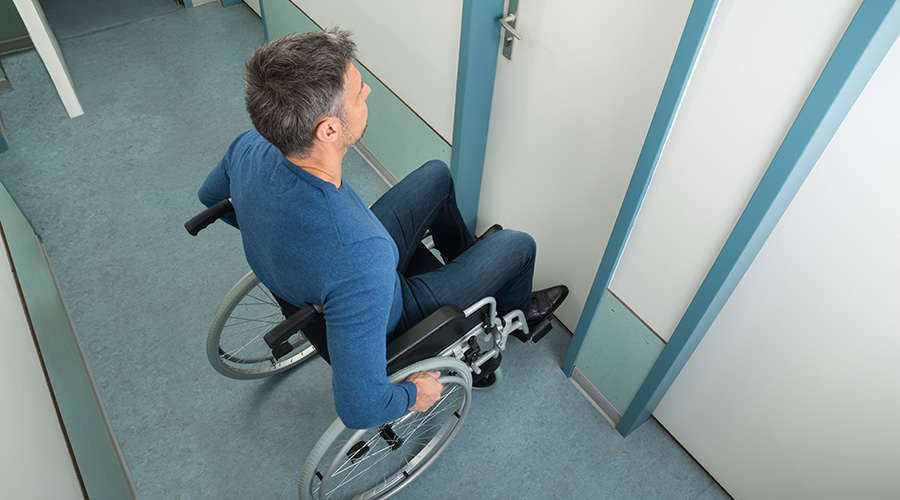Evacuation: The ADA Link
Facility access considerations include ensuring that all building occupants and visitors have a clear path out in an emergency
The events of Sept. 11, 2001, changed lives forever, and they created a turning point in this country by bringing focus to the importance of preparing and responding to emergency situations. A Harris Poll revealed that more than 50 percent of full or part-time employees with disabilities reported that no plans have been made for a safe evacuation from their work place. Additionally, 58 percent of persons with disabilities do not know whom to contact about emergency plans for their home and community in the event of an emergency or disaster.
In light of the attacks of Sept. 11, maintenance and engineering managers involved in planning and preparation for facility emergencies and evacuations must consider three fundamental points:
- Threats to facilities no longer come primarily from fire.
- Managers must place new emphasis on the time it takes to evacuate many people from a high-rise, commercial office structure.
- It is crucial to know who is in a building and, more importantly, to understand their ability to evacuate by means of stairs.
A Shift in Thinking
The rules have changed for managers making accommodations for individuals with disabilities, and so have strategies for complying with ADA access guidelines (ADAAG). Before Sept. 11, the conventional thinking held that asking someone if he or she had a disability could be interpreted as discrimination.
Historically, such a question often was a precursor to attempts by employers to screen out individuals with disabilities from employment opportunities. Before Sept. 11, companies generally were advised that this type of question could be asked only when absolutely essential.
To a considerable extent, that is still true today. What is different is that it has become crucial for facilities professionals to know who is in the building and what difficulties these people might have if it becomes necessary to evacuate the building. That doesn’t mean asking whether a person has a disability. Instead, it means asking who might need assistance and what that assistance might be.
The distinction matters. The U.S. Equal Employment Opportunity Committee (EEOC) sets rules for employers that relate to requesting information about someone’s disability. The federally funded Job Accommodation Network (JAN) also has specific items and suggestions.
The U.S. Access Board — the agency that writes the technical and scoping requirements of the ADA — provides information and guidance. The U.S. Department of Justice also has developed materials related to emergency evacuation procedures.
Employers can ask for information that relates to the safety of employee or others. The optimal approach is to ask all employees — not just those with disabilities — to inform the responsible department or person if and what assistance anyone would need in order to safely evacuate the building during an emergency. With that approach, there is no need to ask someone if he or she has a disability and, if so, to disclose that disability.
Instead, the facilities professional, in asking for information, will make it possible to safely evacuate everyone. Inserts into company newsletters or communications sent out by management to tenants should highlight the organization’s efforts to provide a safe and effective environment for all tenants and visitors.
Managers involved in planning should not assume that individuals with obvious physical disabilities are the only ones who will have difficulties evacuating. Individuals with a range of medical conditions — including asthma or heart conditions — or any occupant who is recuperating from an injury or surgery might have difficulty using steps during an evacuation.
Collecting Information
It can be particularly challenging to get individuals with hidden disabilities — panic disorders, for example — safely out of the building. Anticipating and being prepared for that eventuality will be very important. These guidelines apply whether it is an owner-occupied building, an educational or governmental building, or a multi-use, commercial building.
In commercial buildings with mixed-use tenants that include retail, tenant built-out space, and owner-occupied space, the variety of people in the building at any given moment is virtually unknown. That challenge can lead to these questions:
“If I don’t know who is in my building, how can I know who will need help to evacuate? And what kind of assistance will they need?”
That is why the task of collecting the information and communicating with employees, tenants and visitors is critical. Managers should make good use of signage in buildings. More importantly, they must make sure that security and building personnel are fully aware of procedures and the placement of equipment that is needed in an emergency evacuation.
Planning for Safety
What managers do after collecting the information is the most important step. Once they have determined who within their facilities needs assistance, they need to take important measures to ensure that all tenants and visitors can be evacuated safely.
The first step is to make practice evacuations mandatory. Those who will opt out of the exercise might, in fact, be the very people who will pose the greatest challenges — and most likely will not be ones with disabilities. Practice evacuations with less than the full complement of people in a building also can give a false timeframe for evacuation.
The next step is to refine or develop a safety team consisting of organization and facilities staff. This team presents an opportunity for the development of a program whereby team members are paired with individuals with disabilities to assist them in the evacuation and rescue process.
Remembering the Basics
In developing an emergency evacuation plan for people with disabilities, it is important to remember the basics.
Managers and other team members must work with local fire officials. They also must communicate with all employees, and in multi-tenant buildings, they'll need to communicate with tenants and encourage them to do the same with their employees.
Managers also must make sure everyone knows the location of rescue and evacuation paths. Review in-house equipment to determine whether additional equipment might be needed, and determine the best location for the equipment. Make sure that key safety team members know where the equipment is stored.
Managers also can take several key actions designed to making a facility a safer place for employees, customers and visitors:
- Know what a facility can support. A thorough ADA survey not only will identify barriers to access but will highlight emergency evacuation elements.
- Augment a facility’s structure with emergency evacuation products, such as manual evacuation chairs.
- Look for and document the existence and placement of alarms — both visual and audible — emergency communications, emergency egress and areas of rescue assistance.
- Make sure that paths of travel from restrooms and common areas and spaces provide for adequate clearance.
Installing these items is only the first step. Maintenance and upkeep of these are equally important. Maintenance and engineering managers must make sure that:
- battery back-ups for alarms are in good working order.
- trash cans, urns and other items do not block maneuvering clearances at doors, particularly in rest rooms.
- furniture, boxes and items do not block the path in offices and common spaces.
Nothing can replace a calm and safe evacuation, and that result cannot happen without planning, communication and practice.
The Role of Elevators
The most recent critical issue at hand is the use of passenger elevators as a means of emergency evacuation in multi-story buildings.
Traditionally in an emergency, elevators are inactivated and return automatically to the first floor in order to prevent an elevator from opening onto a floor that already is consumed by fire. But with the changes brought about by events of Sept. 11, 2001, organizations such as National Fire Prevention Association are evaluating and debating this requirement.
The discussions center on when it is feasible to use passenger elevators to evacuate individuals who cannot use the stairs, once it is determined that the emergency affecting the facility is not a fire.
Managers should monitor developments in this area closely, as they are certain to affect planning and preparation for emergency evacuations.
|
Related Topics:











